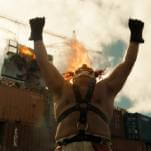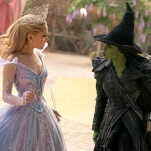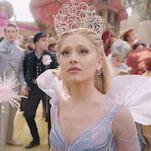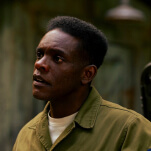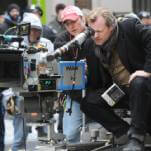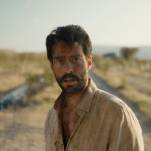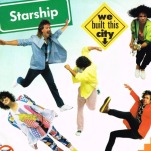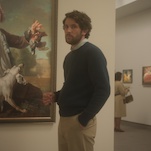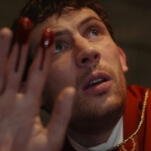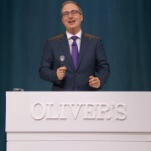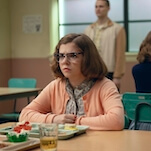Primer is The A.V. Club’s ongoing series of beginners’ guides to pop culture’s most notable subjects: filmmakers, music styles, literary genres, and whatever else interests us—and hopefully you.
Film directors don’t often enter the culturally exclusive arena of household names. Stanley Kubrick, Martin Scorsese, Steven Spielberg, Spike Lee, Christopher Nolan, Wes Anderson—even the most cinematically uninterested have seen pieces of their films. They sit in the upper strata of universal recognition, in the box seats above the game, with A-list actors, pop stars, and world leaders. But in the coveted few courtside seats among the people is the second strata, the ones so consistently singular across a body of work that if someone has seen one of their movies, they know immediately. Everyone has at least heard of someone who’s seen a Sofia Coppola movie, a Paul Thomas Anderson movie, a David Fincher movie, or a Darren Aronofsky movie. Love them or hate them, how does one forget?
With Caught Stealing—the radical filmmaker’s ninth feature (10th, if you’re in Vegas and have $115 to spare for his Sphere-only production Postcard From Earth)—Darren Aronofsky returns home to New York and marks the start of a new chapter. The unapproachable auteur seems to be opening his arms to wider audiences by way of a genre that rewards, if not demands, grit and fuckery, Aronofsky’s stock-in-trade. He’s lived largely in psychological-drama, -thriller, and -horror territory, with regular forays into soul-piercing melodrama and biblically epic fantasy. But he’s never done straightforward crime. So ahead of this pulpy, neo-grunge punk project, The A.V. Club is breaking down Aronofsky’s provocative filmography into a three-part crash course.
Darren Aronofsky 101: The Claustrophiliac
Paranoid-stricken claustrophobia has been Aronofsky’s mood from the get-go. It’s specific to his characters’ perspectives, to his camera approach. In 1998, he brought his debut feature Pi—the first downloadable movie on the internet—to life for a measly $135,000, got into Sundance, won Best Director, and received a $1 million paycheck for it. The gritty, cerebral, cybernetic math thriller hurls viewers into a grainy conspiratorial haze of white-hot 16mm cinematography that chronicles the patterned relationship between nature and number under tremble-inducing duress at the hands of its raving protagonist, Maximillian Cohen (Sean Gullette). Captured in tight spaces in even tighter frames, Pi announced Aronofsky as a visual agitator, a fresh voice in psychological insurgent cinema, and a filmmaker unafraid to stare humanity’s most unsettling fears and obsessions in the face. It even precipitated his fascination with the divine, wrapped up in our need for answers and our predilection for myths to fill in the gaps where there are none.
On top of propelling Aronofsky’s career into a revered arthouse atmosphere, Pi also served as the launchpad for his longtime collaborators Clint Mansell (composer) and Matthew Libatique (cinematographer). As his first and most independent film, Pi is also his least well-known. But its kinetic, confined, and confrontational spirit lies at the core of his two most popular, and, curiously, beloved films: Requiem For A Dream, the chaotic and devastating Pi follow-up that sent him into the Hollywood orbit, and Black Swan, the ballet body-horror thriller that took the world by storm, making over $330 million on a $13 million budget.
The latter is a big haul for a small, squirm-inducing production—especially one that resituated the manic self-incarceration and cramped obsessions of Aronofsky’s first two films inside dollhouse elegance, abstract rehearsal spaces, mirrored interior realms, and the pathological pursuit of perfection. It achieved the kind of success that earns you the directorial freedom to redesign one of humanity’s most famous epics in a way that upsets two of the largest religious masses in the world. But we’ll get to that in the advanced course.
With Requiem For A Dream, his sophomore effort, Aronofsky dove deeper into visceral displeasure, further exploring his style through the lens of both street and pharmaceutical drug addiction, the alignment of the two alone already meant to stir the pot. The dangers of overprescribed pharmaceuticals are common knowledge now, but in 2000, it was socially heretical to suggest that an innocent mother, merely taking “weight pills” prescribed by her doctor in the safety of her home, might be strung out in the same ways as a heroin addict. Ellen Burstyn’s shattered portrayal of said mom was so convincing it earned her her first Oscar nomination in 20 years.
Aronofsky’s adaptation of Hubert Selby Jr.’s immersive, unrelenting, first-hand addiction experience made waves for its constricted paranoia, uncomfortably close lenses, zippy style, warped amphetamine logic, and soul-rotting desperation, the likes of which entertained viewers through morbid curiosity and an inability to look away, even if they hated what they were seeing. The ability to magnetize a subject that real and disturbing—presented disturbingly—showcased how serious Aronofsky was about both his craft and his empathy.
Aronofsky’s career devotion to claustrophilic conflict reached a commercial and critical peak with Black Swan, when he dared enter the world of the most physically demanding artists on the planet: ballerinas. Libatique’s handheld 16mm camerawork, which harkens back to Pi, lends an erratic edge to the body-breaking high society sport that Aronofsky capitalizes on in mind-bending flourishes—not to mention the fresh enclosed territory of dark shoulder-to-shoulder clubs, childhood bedrooms, and aggressive teacher’s offices. Through a prodigious dancer’s hallucinatory perspective, body image and mental stability crumble under the weight of excellence.
Black Swan has remained so prominent in pop culture that it now dwarfs the historic project it swirls around, Swan Lake, in the modern imagination—the latter now a distant performance art memory for future generations who will be familiar with Aronofsky and Portman’s performance. On top of the mammoth box office returns, which set records for limited release movies, Black Swan earned him his first and only Best Director nomination, and his films’ first Oscar win (Natalie Portman for Lead Actress). It also earned him, after five unforgettable features, his unofficial place among the greats.
Intermediate Studies: Existential melodramas
The Whale represents the nth degree of Darren Aronofsky’s infatuation with confinement, yes, but not more significantly than it represents the culmination of his enchantment with the human soul. The rich, maddening complexity of the human condition has always taken center stage in Aronofsky’s work, whether it’s a fantastical exploration of our origins or a dour chamber drama stripped of everything but sincerity.
His smallest and most minor work, The Whale would still have the biggest heart in most filmmaker’s oeuvres. That’s why Brendan Fraser took home the Oscar for his portrayal of the homebound Charlie (as did his hair and makeup team), a remote English teacher with a golden heart who lives every waking moment in the same small apartment as the result of his crippling weight, a fact that rarely gets the optimist down, despite his estrangement from his daughter and nothing to look forward to.
But up against the brilliant characters running throughout Aronofsky’s oeuvre, The Whale is oversteeped. Did playwright Samuel D. Hunter take Aronofsky’s eager melodrama too far, or is the film simply missing the imaginative cinematic language of the rest of his features? Distilled purely from its source play, with only basic cinematic diction in support, The Whale sits on the opposite side of Aronofsky’s existential melodrama spectrum from his first: The Fountain.
The Fountain is a sprawling fantasy epic that spans religions, genres, millennia, and three versions of Hugh Jackman’s grief-stricken lead, who cannot accept the inevitability of death. Tomás, the 16th-century conquistador, searches for The Tree Of Life and its elixir on behalf of his dying queen. Dr. Tommy, the modern-day doctor, tries to cure cancer for his terminally ill wife. Tom, the ethereal bubble-bound space traveler, hurtles through an electrified imagination of the cosmos at an unrecognizable point in the future.
Aronofsky’s investigation of what it means to be alive temporally, and torturously know it, was the poorest received among his films, and one trapped in production hell for what would amount to the longest dry spell of Aronofsky’s career. But where The Whale would later overflow with sentiment to a detrimental degree, The Fountain, his first existential melodrama, floods just to the rim with existential musings you can swim in for the rest of your life.
Before Aronofsky followed The Fountain with The Wrestler, he had an awakening through Jean-Pierre and Luc Dardenne. The influence of the Belgian duo’s kitchen-sink realism flipped the firebrand Brooklynite’s signature style on its head and led to something unrecognizably accessible from him: A minimalist prestige drama that, even in its mature themes, was suited for parents and grandparents alike—at least more so than the cyberpunk acid trips, dingy crossfaded benders, and sweeping philosophical texts that preceded it.
The gut-punch melodrama follows Randy “The Ram” Robinson (Mickey Rourke in a meta-performance for the ages) in a late-life attempt to reconnect with his daughter, saddle up with a stripper he falls in love with, and find some sense of normalcy outside the wrestling ring. Much like The Whale, there’s little more to the story than what’s on paper, but where The Whale lacks energy in its static setting and meager characters, The Wrestler harbors a dynamism provided by the action- and misery-packed matches hovering over The Ram’s livelihood, and the question of what life is worth to him at all.
That’s not to say The Wrestler is easy to choke down. Per Aronofsky’s approach to anything, the realism is as blunt as it is painful, stripping everything but the believable from the lonely, self-forsaken brute at the bleeding heart of the story. A Dardenne-like empathy floods the film, making the relatable real-world blows (botched attempts to connect with a family member or keep a job) hurt like they’re happening to us. While it would fit neatly into a Dardennes double feature, The Wrestler is as hard to swallow as Requiem or Black Swan through its heartwrenching melodrama—a uniquely Aronofsky feat.
Advanced Studies: Aronofsky the theologian
In Rabbinic tradition, Midrash is an interpretive reading of scripture that reimagines biblical stories by looking beyond what’s written, filling in the gaps and posing new questions. Raised culturally Jewish in Manhattan Beach, Brooklyn—the setting of Requiem—Aronofsky has never been religious, but he’s always marveled at religiosity, at the myths passed down across generations.
Aronofsky posited himself as a Midrashic mythmaker when he expanded the cherished tale of Noah’s Ark into Noah: an equal parts phantasmagorical, supplementary, and realistic—yet, in being so, provocative—character study of a man who, in faith, finds himself in an impossibly difficult situation, and, in community, not so much.
An Aronofsky brand of psychological horror is embedded in Noah‘s central question: How might things have unfolded if this really happened to someone? The idea, the tension, is palpably upsetting. On one side is a gnostic truth, divinely implanted, that the viewer holds more certainly than Noah himself, an unwitting participant in God’s great species-wide reset. On the other is a call to humane behavior, a necessity that, if abandoned, leaves justice and morality in the wind.
Aronofsky’s flood story details angels enslaved in Earth’s stone for trying to help people against God’s wishes. It favors a silent God over the Old Testament’s chatty Kathy. It imagines a passionately vegan Noah, psychedelics as vehicles for holy visions, and a humanism that crowns divinity, among other righteous blasphemies. It was a behemoth of a project. The religious promiscuity, gargantuan narrative, A-list talent, and VFX weight of Noah led Aronofsky to his only public studio quarrel, trading final cut to Paramount in return for a secure $115 million budget, by far the largest of his career. Aronofsky eventually won out, though, when the studio’s edits didn’t test as well as executives had hoped.
Just three years later, as if the Book Of Genesis wasn’t literary enough in its mythmaking, Aronofsky devised an allegorical reworking of the biblical beginning in the abrasive form of mother!, filling out the impressionistic story with his tendency to color inside and very, very far outside of the lines. Adam and Eve as rude house guests, and Cain and Abel their vengeful adult children? Inside the lines. God as a selfish author with writer’s block he can only shake by elaborately tormenting his pregnant wife, and a Mother Nature who is better off without us…all of us? Outside the lines, pure scandal.
In that sense, mother! is Aronofsky’s most incendiary film. Few moments have been more shocking in modern cinema than the sudden entrance of a woman who shoots three head-bagged prisoners, on the ground, point blank in the face. One of the only moments to trump it is the following shot’s reveal that the trigger-happy executioner is, inexplicably, Kristen Wiig. Why? mother! is all about open interpretation. Bedlam, babel, Bardem, and baby Jesus torn into literal bits of body and blood ravenously consumed by rioting masses. That’s mother!
Together, Aronofsky’s Midrashim explores the raw, rampant edge of a traditional, monotheistic Judeo-Christian God’s depravity—the deity’s penchant for violence, narcissism, and abandonment. It brings “God” down to “god” with a human touch that’s unfortunately, and eye-openingly, relatable in ways that reflect our own salacious attempts to play God. It’s also another reminder that, with whatever story he’s telling, Aronofsky is a capital-P Provocateur, in the ranks of Pier Paolo Pasolini and Lars von Trier.


